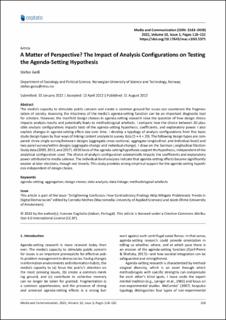| dc.contributor.author | Geiss, Stefan | |
| dc.date.accessioned | 2023-02-28T09:00:25Z | |
| dc.date.available | 2023-02-28T09:00:25Z | |
| dc.date.created | 2022-11-10T12:52:14Z | |
| dc.date.issued | 2022 | |
| dc.identifier.citation | Media and Communication. 2022, 10 (3), 118-132. | en_US |
| dc.identifier.issn | 2183-2439 | |
| dc.identifier.uri | https://hdl.handle.net/11250/3054533 | |
| dc.description.abstract | Abstract: The media’s capacity to stimulate public concern and create a common ground for issues can counteract the fragmentation of society. Assessing the intactness of the media’s agenda-setting function can be an important diagnostic tool for scholars. However, the manifold design choices in agenda-setting research raise the question of how design choice impacts analysis results and potentially leads to methodological artefacts. I compare how the choice between 20 plausible analysis configurations impacts tests of the agenda-setting hypothesis, coefficients, and explanatory power. I also explore changes in agenda-setting effect size over time. I develop a typology of analysis configurations from five basic study design types by four ways of linking content analysis to survey data (5 × 4 = 20). The following design types are compared: three single-survey/between designs (aggregate-cross-sectional, aggregate-longitudinal, and individual-level) and two panel-survey/within designs (aggregate-change and individual-change). I draw on the German Longitudinal Election Study data (2009, 2013, and 2017). All 20 tests of the agenda-setting hypothesis support the hypothesis, independent of the analytical configuration used. The choice of analysis configuration substantially impacts the coefficients and explanatory power attributed to media salience. The individual-level analyses indicate that agenda-setting effects became significantly weaker at later elections, though not linearly. This study provides strong empirical support for the agenda-setting hypothesis independent of design choice. | en_US |
| dc.language.iso | eng | en_US |
| dc.publisher | Cogitatio | en_US |
| dc.rights | Navngivelse 4.0 Internasjonal | * |
| dc.rights.uri | http://creativecommons.org/licenses/by/4.0/deed.no | * |
| dc.title | A Matter of Perspective? The Impact of Analysis Configurations on Testing the Agenda‐Setting Hypothesis | en_US |
| dc.title.alternative | A Matter of Perspective? The Impact of Analysis Configurations on Testing the Agenda‐Setting Hypothesis | en_US |
| dc.type | Peer reviewed | en_US |
| dc.type | Journal article | en_US |
| dc.description.version | publishedVersion | en_US |
| dc.source.pagenumber | 118-132 | en_US |
| dc.source.volume | 10 | en_US |
| dc.source.journal | Media and Communication | en_US |
| dc.source.issue | 3 | en_US |
| dc.identifier.doi | 10.17645/MAC.V10I3.5375 | |
| dc.identifier.cristin | 2071822 | |
| cristin.ispublished | true | |
| cristin.fulltext | original | |
| cristin.qualitycode | 1 | |

